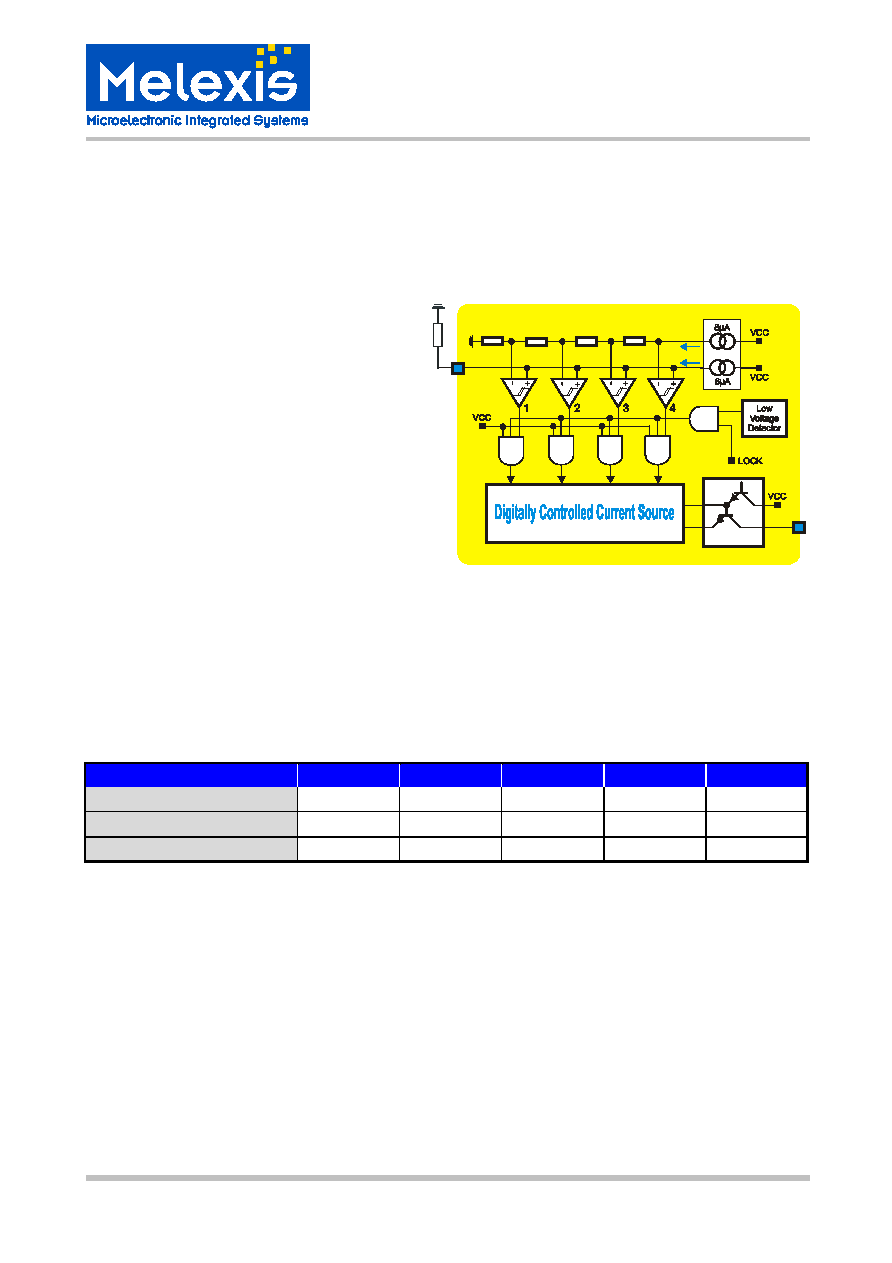- 您現(xiàn)在的位置:買賣IC網(wǎng) > PDF目錄97935 > EVB72011 EVB72011 EValuation Board for TH72011 PDF資料下載
參數(shù)資料
| 型號: | EVB72011 |
| 英文描述: | EVB72011 EValuation Board for TH72011 |
| 中文描述: | EVB72011評估板TH72011 |
| 文件頁數(shù): | 8/12頁 |
| 文件大小: | 307K |
| 代理商: | EVB72011 |

EVB72001
315MHz FSK Transmitter
Evaluation Board Description
390127200101
Page 5 of 12
EVB Description
Rev. 002
Oct/02
PR
EL
IM
INA
RY
2.4
Output Power Selection
The transmitter is provided with an output power selection feature. There are four predefined output power
steps and one off-step accessible via the power selection pin PSEL. A digital power step adjustment was
chosen because of its high accuracy and stability. The number of steps and the step sizes as well as the
corresponding power levels are selected to cover a wide spectrum of different applications.
The implementation of the output power control
logic is shown in figure 4. There are two
matched current sources with an amount of
about 8 A. One current source is directly
applied to the PSEL pin. The other current
source is used for the generation of reference
voltages with a resistor ladder. These reference
voltages are defining the thresholds between
the power steps. The four comparators deliver
thermometer-coded control signals depending
on the voltage level at the pin PSEL. In order to
have a certain amount of ripple tolerance in a
noisy
environment
the
comparators
are
provided with a little hysteresis of about 20 mV.
With these control signals, weighted current
sources of the power amplifier are switched on
or off to set the desired output power level
(Digitally
Controlled
Current
Source).
The
LOCK signal and the output of the low voltage
detector are gating this current source.
Fig. 4: Block diagram of output power control circuitry
There are two ways to select the desired output power step. First by applying a DC voltage at the pin PSEL,
then this voltage directly selects the desired output power step. This kind of power selection can be used if
the transmission power must be changed during operation. For a fixed-power application a resistor can be
used which is connected from the PSEL pin to ground. The voltage drop across this resistor selects the
desired output power level. For fixed-power applications at the highest power step this resistor can be
omitted. The pin PSEL is in a high impedance state during the “TX standby” mode.
typical values at TA = 23 °C and VCC
≥ 4 V
Power step
0
1
2
3
4
Pout / dBm
< -70
-15
-6
0
6
RPS / k
< 10
22
47
100
> 220
VPS / V
0.1
0.14 to 0.24
0.28 to 0.51
0.57 to 1.18
> 1.23
2.5
Lock Detection
The lock detection circuitry turns on the power amplifier only after PLL lock. This prevents from unwanted
emission of the transmitter if the PLL is unlocked.
2.6
Low Voltage Detection
The supply voltage is sensed by a low voltage detect circuitry. The power amplifier is turned off if the supply
voltage drops below a value of about 1.85 V. This is done in order to prevent unwanted emission of the
transmitter if the supply voltage is too low.
&
PSEL
&
RPS
OUT
相關(guān)PDF資料 |
PDF描述 |
|---|---|
| EVB72012 | EVB72012 EValuation Board for TH72012 |
| EVB72031 | EVB72031 EValuation Board TH72031 |
| EVB72032 | EVB72032 EValuation Board for TH72032 |
| EVKIT | 3.3V Palmtop Computer and Flash Memory Power Supply Regulator |
| EVM-1702 | EVM-1702 - EVALUATION MODULE |
相關(guān)代理商/技術(shù)參數(shù) |
參數(shù)描述 |
|---|---|
| EVB72012 | 制造商:未知廠家 制造商全稱:未知廠家 功能描述:EVB72012 EValuation Board for TH72012 |
| EVB72013-433-FSK-C | 制造商:Melexis Semiconductors 功能描述:Evaluation Board for MLX72013 433 Mhz FSK Transmitter |
| EVB72015 | 制造商:MELEXIS 制造商全稱:Melexis Microelectronic Systems 功能描述:433MHz FSK/ASK Transmitter Evaluation Board Description |
| EVB72015-315-ASK-A | 制造商:MELEXIS 制造商全稱:Melexis Microelectronic Systems 功能描述:433MHz FSK/ASK Transmitter Evaluation Board Description |
| EVB72015-315-ASK-C | 制造商:MELEXIS 制造商全稱:Melexis Microelectronic Systems 功能描述:433MHz FSK/ASK Transmitter Evaluation Board Description |
發(fā)布緊急采購,3分鐘左右您將得到回復(fù)。